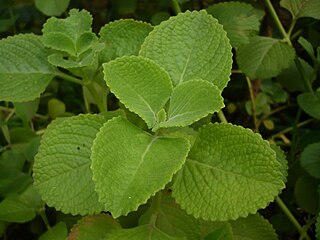
The Lamiaceae or Labiatae are a family of flowering plants commonly known as the mint, deadnettle or sage family. Many of the plants are aromatic in all parts and include widely used culinary herbs like basil, mint, rosemary, sage, savory, marjoram, oregano, hyssop, thyme, lavender, and perilla, as well as other medicinal herbs such as catnip, salvia, bee balm, wild dagga, and oriental motherwort. Some species are shrubs, trees, or, rarely, vines. Many members of the family are widely cultivated, not only for their aromatic qualities, but also their ease of cultivation, since they are readily propagated by stem cuttings. Besides those grown for their edible leaves, some are grown for decorative foliage. Others are grown for seed, such as Salvia hispanica (chia), or for their edible tubers, such as Plectranthus edulis, Plectranthus esculentus, Plectranthus rotundifolius, and Stachys affinis. Many are also grown ornamentally, notably coleus, Plectranthus, and many Salvia species and hybrids.

Plectranthus is a genus of about 85 species of flowering plants from the sage family, Lamiaceae, found mostly in southern and tropical Africa and Madagascar. Common names include spur-flower. Plectranthus species are herbaceous perennial plants, rarely annuals or soft-wooded shrubs, sometimes succulent; sometimes with a tuberous base.

Coleus scutellarioides, commonly known as coleus, is a species of flowering plant in the family Lamiaceae, native to southeast Asia through to Australia. Typically growing to 60–75 cm (24–30 in) tall and wide, it is a bushy, woody-based evergreen perennial, widely grown for the highly decorative variegated leaves found in cultivated varieties. Another common name is painted nettle, reflecting its relationship to deadnettles, which are in the same family. The synonyms Coleus blumei, Plectranthus scutellarioides and Solenostemon scutellarioides are also widely used for this species.
Coleus cataractarum, synonym Plectranthus cataractarum, is a species of flowering plant in the family Lamiaceae. It is found in Cameroon and Equatorial Guinea. Its natural habitats are subtropical or tropical moist lowland forests and rivers, near waterfalls. It is threatened by habitat loss.
Coleus socotranus, synonym Plectranthus socotranus, is a species of flowering plant in the family Lamiaceae.
Coleus unguentarius, synonym Plectranthus unguentarius, is a species of flowering plant in the family Lamiaceae. It is found only in Namibia. Its natural habitat is rocky areas. It is threatened by habitat loss.

Lemurophoenix halleuxii is a species of palm tree, the only species in the genus Lemurophoenix. It is found only in Madagascar. It is threatened by habitat loss and overcollection. There are perhaps 300 mature individuals remaining in the wild.
Carlephyton madagascariense is a plant species in the genus Carlephyton endemic to Madagascar.

Coleus is a genus of annual or perennial herbs or shrubs, sometimes succulent, sometimes with a fleshy or tuberous rootstock, found in the Afro-Eurasia tropics and subtropics.

Capitanopsis is a genus of plants in the family Lamiaceae, first described in 1916. It contains six known species, all endemic to Madagascar.

Coleus fredericii, synonym Plectranthus welwitschii, is a species of plant in the family Lamiaceae. The epithet is also spelt frederici.

Nepetoideae is a subfamily of plants in the family Lamiaceae.
Equilabium is a genus of flowering plants in the family Lamiaceae. It was split off from the genus Plectranthus in 2018 as the result of a molecular phylogenetic study. Most species are native to Africa, with two found in the Indian subcontinent.

Capitanopsis brevilabra is a species of flowering plant in the family Lamiaceae. It is an herb or shrub native to southeastern Madagascar. It flowers in March.
Capitanopsis oreophila, synonym Plectranthus bipinnatus, is a species of flowering plant in the family Lamiaceae. It is a small shrub native to Madagascar, where it is commonly known as andriamborondrao.
Gereaua is a monotypic genus of flowering plants belonging to the family Sapindaceae. It only contains one species, Gereaua perrieri.

Henonia is a monotypic genus of flowering plants belonging to the family Amaranthaceae. It only contains one species, Henonia scoparia.
Pilgerina is a monotypic genus of flowering plants belonging to the family Santalaceae. It only contains one known species, Pilgerina madagascariensis.

Salvadoropsis is a monotypic genus of flowering plants belonging to the family Celastraceae. It only contains one known species, Salvadoropsis arenicola.
Humbertiodendron is a monotypic genus of flowering plants belonging to the family Trigoniaceae. The only species is Humbertiodendron saboureaui.










